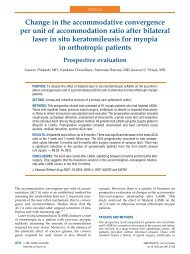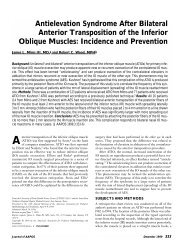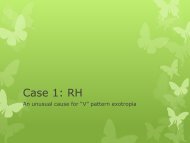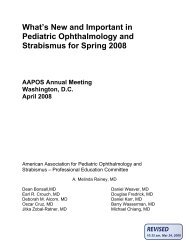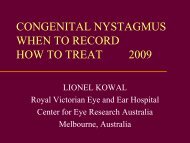Epidemiology of amblyopia - The Private Eye Clinic
Epidemiology of amblyopia - The Private Eye Clinic
Epidemiology of amblyopia - The Private Eye Clinic
Create successful ePaper yourself
Turn your PDF publications into a flip-book with our unique Google optimized e-Paper software.
Seminar<br />
effective, but recent data indicating an absence <strong>of</strong> age<br />
effect should question this assertion.<br />
Subtle ocular and cerebral pathology could underlie<br />
failure to respond to treatment. Optic nerve hypoplasia is<br />
easily missed on indirect ophthalmoscopy and should be<br />
specifically excluded. Inaccurate refractive correction,<br />
which inevitably occurs during periods <strong>of</strong> emmetropisation,<br />
should also be considered. Lack <strong>of</strong> compliance<br />
(concordance), as discussed earlier, is also a factor.<br />
<strong>The</strong> approach to an individual in whom vision initially<br />
improves and then seems to plateau is far from clear.<br />
Attempts to improve compliance with a specific regimen,<br />
followed by increasing the number <strong>of</strong> hours per day, are<br />
reasonable. Nevertheless, since only 50% <strong>of</strong> children ever<br />
reach normal visual acuity, to continue patching<br />
indefinitely until visual acuity reaches 6/6 would be<br />
unreasonable. Although some investigators feel all<br />
improvement is seen in the first 12 weeks, 72 other studies<br />
suggest extended courses. 61<br />
Other methods <strong>of</strong> treating <strong>amblyopia</strong><br />
Optical penalisation<br />
Blurring <strong>of</strong> the sound eye by use <strong>of</strong> optical means in a<br />
spectacle correction or contact lens has been reported to<br />
successfully treat <strong>amblyopia</strong> 91 but has not yet been<br />
subject to a randomised clinical trial.<br />
Near activities while patching<br />
Although many practitioners instruct children to do near<br />
activities or activities that need hand-eye coordination<br />
while patching, the issue has not been rigorously studied.<br />
A pilot study 92 was undertaken by PEDIG to determine<br />
whether children would stay in their assigned groups if<br />
randomised to near or distance activities, and data for<br />
visual acuity suggested a modest benefit <strong>of</strong> near activities.<br />
A full-scale randomised controlled trial is currently<br />
underway to address this issue. 92<br />
Levodopa and citocholine<br />
Oral levodopa has been reported in <strong>amblyopia</strong> treatment<br />
and has shown effects seen on both visual acuity and<br />
functional MRI. 93–96 Citocholine has been reported to<br />
have similar effects. 97,98 <strong>The</strong> neuro psychiatric side-effects<br />
<strong>of</strong> these drugs render their use unlikely in routine<br />
clinical practice for <strong>amblyopia</strong> treatment, but the<br />
studies do show the potential for such an approach to<br />
treat ment.<br />
Visual stimulation<br />
Since the use <strong>of</strong> the CAM (Cambridge) stimulator, 99 there<br />
has been interest in the use <strong>of</strong> positive visual stimulation<br />
compared with occlusion or penalisation, but this<br />
treatment has not shown to be beneficial in randomised<br />
trials. <strong>The</strong> role <strong>of</strong> near visual tasks as an adjunct to<br />
patching has been a feature <strong>of</strong> some trials, 38,54 and is<br />
currently being investigated, 92 as are other computerbased<br />
systems. 100,101<br />
Future developments and implications<br />
Continuing and planned research will provide further<br />
evidence on: the role <strong>of</strong> near-activities while patching,<br />
atropine in more severe <strong>amblyopia</strong>, combined optical and<br />
atropine penalisation, atropine versus patching in older<br />
children with <strong>amblyopia</strong>, and the effectiveness <strong>of</strong> blurring<br />
filters. <strong>The</strong> past few years have heralded a new era in<br />
evidence-based treatment for <strong>amblyopia</strong>, increasing the<br />
options and reducing the burden for the child and family.<br />
Conflict <strong>of</strong> interest statement<br />
We declare that we have no conflict <strong>of</strong> interest with respect to the writing<br />
<strong>of</strong> this Seminar.<br />
Acknowledgments<br />
J M Holmes is funded by grants from the National Institutes <strong>of</strong> Health,<br />
Bethesda, MD, USA (EY015799 and EY011751); Research to Prevent<br />
Blindness Inc, New York, NY, USA (Olga Keith Weiss Scholar); and an<br />
unrestricted grant to the Department <strong>of</strong> Ophthalmology, Mayo <strong>Clinic</strong><br />
College <strong>of</strong> Medicine.<br />
References<br />
1 von Noorden GK, Campos E. Binocular vision and ocular motility,<br />
6th edn. St Louis, MO: Mosby, 2002.<br />
2 Hubel DH, Wiesel TN. <strong>The</strong> period <strong>of</strong> susceptibility to the<br />
physiological effects <strong>of</strong> unilateral eye closure in kittens. J Physiol<br />
1970; 206: 419–36.<br />
3 Goodyear BG, Nicolle DA, Humphrey GK, Menon RS. Bold fMRI<br />
response <strong>of</strong> early visual areas to perceived contrast in human<br />
<strong>amblyopia</strong>. J Neurophysiol 2000; 84: 1907–13.<br />
4 McKee SP, Levi DL, Movshon JA. <strong>The</strong> pattern <strong>of</strong> visual deficits in<br />
<strong>amblyopia</strong>. J Vision 2003; 3: 380–405.<br />
5 Williams C, Papakostopoulos D. Electro-oculographic abnormalities<br />
in <strong>amblyopia</strong>. Br J Ophthalmol 1995; 79: 218–24.<br />
6 von Noorden GK, Crawford ML. <strong>The</strong> lateral geniculate nucleus<br />
inhuman strabismic <strong>amblyopia</strong>. Invest Ophthalmol Vis Sci 1992; 33:<br />
2729–32.<br />
7 Davis AR, Sloper JJ, Neveu MM, Hogg CR, Morgan MJ,<br />
Holder GE. Electrophysiological and psychophysical differences<br />
between early- and late-onset strabismic <strong>amblyopia</strong>.<br />
Invest Ophthalmol Vis Sci 2003; 44: 610–17.<br />
8 von Nooden GK, Crawford ML. <strong>The</strong> sensitive period.<br />
Trans Ophthalmol Soc UK 1979; 99: 442–46.<br />
9 Holmes JM, Beck RW, Repka MX, et al. <strong>The</strong> <strong>amblyopia</strong> treatment<br />
study visual acuity testing protocol. Arch Ophthalmol 2001; 119:<br />
1345–53.<br />
10 Attebo K, Mitchell P, Cumming R, et al. Prevalence and causes <strong>of</strong><br />
<strong>amblyopia</strong> in an adult population. Ophthalmology 1998; 105: 154–59.<br />
11 National <strong>Eye</strong> Institute Office <strong>of</strong> Biometry and <strong>Epidemiology</strong>. Report<br />
on the National <strong>Eye</strong> Institute’s Visual Acuity Impairment Survey<br />
Pilot Study. Washington, DC: US Department <strong>of</strong> Health and<br />
Human Services, 1984.<br />
12 Holmes JM, Leske DA, Burke JP, Hodge DO. Birth prevalence <strong>of</strong><br />
visually significant infantile cataract. Ophthalmic Epidemiol 2003; 10:<br />
67–74.<br />
13 Rahi JS, Dezateux C. National cross sectional study <strong>of</strong> detection <strong>of</strong><br />
congenital and infantile cataract in the United Kingdom: role <strong>of</strong><br />
childhood screening and surveillance. <strong>The</strong> British Congenital<br />
Cataract Interest Group. BMJ 1999; 318: 362–65.<br />
14 Pediatric <strong>Eye</strong> Disease Investigator Group. A randomized trial <strong>of</strong><br />
atropine vs patching for treatment <strong>of</strong> moderate <strong>amblyopia</strong> in<br />
children. Arch Ophthalmol 2002; 120: 268–78.<br />
15 Pediatric <strong>Eye</strong> Disease Investigator Group. <strong>The</strong> clinical pr<strong>of</strong>ile <strong>of</strong><br />
moderate <strong>amblyopia</strong> in children younger than 7 years.<br />
Arch Ophthalmol 2002; 120: 281–87.<br />
16 Wright KW, Edelman PM, Walonker F, Yiu S. Reliability <strong>of</strong> fixation<br />
preference testing in diagnosing <strong>amblyopia</strong>.<br />
Arch Ophthalmol 1986; 104: 549–53.<br />
17 Wallace D. Tests <strong>of</strong> fixation preference for <strong>amblyopia</strong>.<br />
Am Orthopt J 2005; 55: 76–81.<br />
18 Getz LM, Dobson V, Luna B, Mash C. Interobserver reliability <strong>of</strong> the<br />
Teller Acuity Card procedure in pediatric patients.<br />
Invest Ophthalmol Vis Sci 1996; 37: 180–87.<br />
www.thelancet.com Vol 367 April 22, 2006 1349



